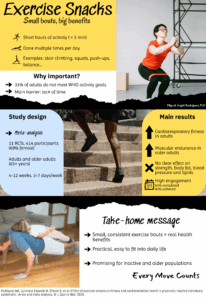Authors: Miguel Ángel Rodríguez, Marcos Quintana-Cepedal, Boris Cheval, Cecilie Thøgersen-Ntoumani, Irene Crespo, Hugo Olmedillas
Why is this study important?
Physical inactivity is one of the most pressing global health challenges of the 21st century. According to the World Health Organization (WHO), more than 1.8 billion adults are at increased risk of chronic diseases because they do not achieve the recommended levels of physical activity (PA). About 31% of adults and 80% of adolescents worldwide do not achieve the minimum guidelines (1, 2). This lack of PA contributes not only to non-communicable diseases and premature deaths, but also places an enormous burden on healthcare systems and economies.
One of the most common barriers people report is a lack of time (3). Even when individuals recognize the benefits of PA, the perception that exercise requires long sessions often discourages people from starting or maintaining an active lifestyle. This raises an important question: could short, simple bouts of exercise spread throughout the day provide real health benefits?
This is where the concept of exercise snacks comes in. Exercise snacks are short, structured bouts of PA that are performed multiple times a day (4). They can be as simple as climbing stairs, doing bodyweight exercises, or practicing balance routines. But until now, the evidence on their effectiveness for improving fitness and cardiometabolic health had been limited and scattered (5).
How did the study go about this?
We conducted a systematic review and meta-analysis, which means we systematically searched, selected, and analysed all available randomized controlled trials that had tested exercise snacks. After screening more than 6,000 articles, we included 11 RCTs involving 414 participants. These were sedentary or physically inactive adults and older adults, with interventions lasting between 4 and 12 weeks.
The exercise snack protocols varied in frequency (from 3 to 7 days per week), intensity (moderate-to-vigorous up to near-maximal effort), and type (stair climbing, strength exercises, tai chi). Importantly, all interventions used short bouts of five minutes or less, performed at least twice daily.
We looked at a wide range of outcomes: cardiorespiratory fitness, muscular strength and endurance, body composition, blood pressure, blood lipids, and adherence to the intervention.
What did the study find?
Our study showed that exercise snacks resulted in meaningful improvements in cardiorespiratory fitness in adults and in muscular endurance in older adults. Importantly, these benefits were achieved with exercise volumes far below current WHO recommendations, highlighting that consistent small bouts of activity can go a long way.
On the other hand, we did not find clear improvements in muscular strength, body fat, blood pressure, or blood lipid profiles. One explanation is that most participants were already relatively healthy at baseline, leaving less room for noticeable changes in these markers.
A particularly encouraging finding was the high engagement: over 90% of participants completed the prescribed sessions, and arround 83% adhered to the routines as planned. These adherence rates surpass what is typically reported for longer, more demanding exercise programs. This suggests that exercise snacks are not only effective but also practical and well accepted, making them a promising option for real-world, unsupervised settings.
What are the key take-home points?
This systematic review and meta-analysis shows that exercise snacks are a promising, time-efficient strategy for improving fitness in inactive populations. They may not replace traditional exercise for all health outcomes, but they can lower the barrier to starting and sustaining PA.
For adults, even brief bouts of vigorous stair climbing or similar exercises can meaningfully boost cardiorespiratory fitness. For older adults, short daily routines focused on strength and balance can improve muscular endurance. These gains are particularly important given the strong links between fitness, independence, and long-term health.
In short:
- Any movement counts. Even small doses of structured PA can be beneficial.
- Consistency matters. Short bouts add up when repeated daily.
- Feasibility is key. High adherence rates suggest that people find exercise snacks easier to integrate into their lives than longer workouts.
Although more research is needed on cardiometabolic outcomes and across more diverse populations, our study highlights the potential of exercise snacks as a practical complement to public health strategies. For individuals who struggle to find time for exercise, the message is simple: every step, every flight of stairs, and every mini-session of PA can make a difference.

References
- Strain, T. et al. National, regional, and global trends in insufficient physical activity among adults from 2000 to 2022: a pooled analysis of 507 population-based surveys with 5·7 million participants. Lancet Glob. Health 12, e1232–e1243 (2024).
- Guthold, R., Stevens, G. A., Riley, L. M. & Bull, F. C. Global trends in insufficient physical activity among adolescents: a pooled analysis of 298 population-based surveys with 1·6 million participants. Lancet Child Adolesc. Health 4, 23–35 (2020).
- Healy, S. et al. It’s about time to exercise: development of the Exercise Participation Explained in Relation to Time (EXPERT) model. Br. J. Sports Med. (2024) doi:10.1136/bjsports-2024-108500.
- Hartley, H., Lee, I.-M. & Ferrari, N. An ‘exercise snack’ plan. Newsweek 149, 60, 63 (2007).
- Islam, H., Gibala, M. J. & Little, J. P. Exercise Snacks: A Novel Strategy to Improve Cardiometabolic Health. Exerc. Sport Sci. Rev. 50, 31–37 (2022).